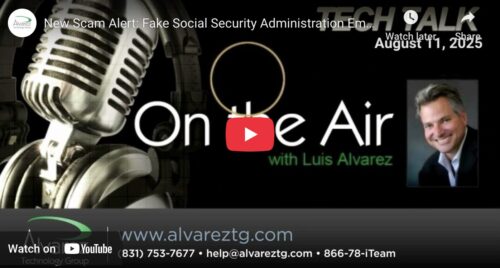Beware Of Fake Payment Invoices & Messages: How To Identify and Avoid Scams
Fake payment invoices and bogus messages are a growing threat. They can trick you into sending money or personal information to criminals.
Knowing how to spot and verify suspicious payment requests is essential to protect your business or personal finances. Scammers usually disguise these invoices as legitimate, often using familiar company names or urgent language.
You might get emails or messages demanding payment for things you never ordered. Sometimes, they ask you to update billing info in a way that seems subtle but isn’t.
These schemes prey on busy routines and hope to catch you off guard. Your financial security could be at risk if you’re not careful.
Key Takeaways
- Fake invoices and messages target both individuals and businesses.
- Clear habits for reviewing payment requests help prevent financial losses.
- Awareness of scam tactics is key for ongoing protection.
What Are Fake Payment Invoices & Messages?
Scammers use fake payment invoices and messages to trick people or businesses into sending money or sharing sensitive information. These scams often look convincing and can slip past your guard if you’re not paying close attention.
Standard Formats and Delivery Methods
Most fake invoices arrive by email, but regular mail, fax, text messages, or even phone calls aren’t off the table—scammers like to pose as legitimate vendors, suppliers, or service providers.
Sometimes they claim to represent big companies or government agencies. Email’s still the favorite for sending fake invoices.
You’ll probably see urgent subject lines or high-dollar amounts to get you to act fast. Attachments, payment links, and fake company names are all part of their toolkit.
Requests might ask for wire transfers, gift cards, or direct payments to new accounts. They’re usually marked as urgent, hoping you’ll move quickly and not notice anything’s off.
Fake invoice fraud is a common way criminals pull off business email compromise.
Differences Between Genuine and Fake Invoices
Real invoices have accurate details: correct company names, addresses, and itemized lists of what you bought. They usually match your previous orders or contracts and come from trusted contacts.
Fake ones? You might spot spelling mistakes, weird sender emails, or logos that don’t quite match. Payment instructions might differ from what’s on file, and sometimes the sender is pushy or threatens service interruptions.
Genuine invoices line up with recent transactions. If you see an invoice pop up out of nowhere, referencing something you never ordered, that’s a big red flag. Always double-check invoice details with your records before paying anything.
Red Flags to Watch For
Look for urgent language like “Immediate Payment Required,” misspelled words, or odd billing amounts. Check sender emails for subtle changes—extra letters or weird domains can be a giveaway.
Unfamiliar account details, last-minute changes in payment instructions, or requests to pay unknown bank accounts should raise your guard. Be wary of attachments or links asking for sensitive information.
If you don’t recognize the organization or the vague invoice, pause before acting. For more tips, check out the invoice scam guide, Bill.com’s advice, and PayPal’s tips.

How Scammers Target Individuals and Businesses
Criminals use digital deception to get employees and individuals to pay fake invoices or hand over sensitive information. They play on your trust in familiar processes and tweak their methods to look credible.
Phishing Techniques Used in Fake Invoices
Phishing scams are emails or messages that look like they’re from real vendors or departments. You might see authentic business logos, familiar invoice formats, or even names you know.
These messages often include attachments or links set up to steal your credentials or send money to the wrong place. Warning signs? Slight changes in the sender’s email, urgent or weird payment requests, and sloppy spelling.
Scammers sometimes mimic real invoice details to fool you. Some even use hacked email accounts to make everything seem legit—a trick called Business Email Compromise.
If you’re suspicious, try this:
- Call known contacts to confirm payment requests
- Double-check email addresses for odd changes
- Be careful with attachments or links in emails asking for money
Social Engineering and Impersonation Tactics
Social engineering attacks try to get you to skip regular checks. Scammers might pretend to be company execs, vendors, or IT staff.
They use public info—like the name of your accounts person—to make their requests sound legit. Sometimes they call or email with stories about missed deadlines or changed bank numbers.
Fraudsters might even impersonate real businesses you’ve dealt with, just tweaking the payment details so your money goes to them—more on these tricks at Scamwatch.
Watch for:
- Sudden changes in banking info
- Requests to rush payments or skip approvals
- Messages that don’t match your usual payment process
Honestly, just picking up the phone and confirming with your real contacts is probably your safest bet.
Identifying and Verifying Payment Requests
Fake payment invoices and messages are everywhere these days. You need to take practical steps before sending money to anyone.
Cross-check the source, verify account details, and use trusted communication channels. Spotting questionable requests can save you from a headache—or worse.
Steps to Authenticate Invoice Sources
Look for things that don’t add up—unfamiliar sender addresses, odd invoice numbers, or company details that seem off. Does the invoice match the format you usually get from that vendor?
Compare the invoice amount to your records. If the request is urgent or threatens consequences, get skeptical.
Keep a list of trusted vendors and contacts handy. Double-check if the invoice refers to a real purchase order or agreement.
Match documentation and payment requests to your records. You’ll find more about this in the guides about identifying fake invoices.
Verifying Payment Accounts and Details
Go over the payment info, such as bank account, business name, and address. Make sure it matches your official records before you move any money.
Log in independently and check the request if you use PayPal or similar platforms. Don’t click links from emails or texts.
Never share financial info unless you’re certain the request is legitimate. Scammers love to trick people into sending funds to their accounts, as seen in scam warnings on PayPal invoices.
For international payments, check SWIFT/BIC codes and other identifiers. Even tiny errors in account numbers should make you stop and dig deeper.
Contact Methods to Confirm Requests
Reach out to the invoicing company using contact info you already have or on their official website. Don’t use numbers or emails from a suspicious invoice.
Call your usual account manager or supplier rep to confirm the payment request. Never reply to contacts listed in the payment message—they could be scammers.
Consider a video call or face-to-face meeting for confirmation if it’s urgent or a big payment. According to industry experts, using secure, separate channels to verify requests reduces fraud risk.
Preventive Measures and Best Practices
Reducing the risk of fake invoices and payment messages takes transparent internal processes, alert staff, careful checks, and secure payment methods. These steps can help spot fraud attempts early and keep your money safe.
Setting Up Internal Controls
Internal controls make it harder for fraudsters to slip through. Assign different people to approve invoices, make payments, and handle bookkeeping.
Use checklists to review invoice details—company names, payment amounts, and due dates. It requires two people to sign off on big payments.
Document all approvals and any changes to supplier or payment info. Look for odd sender info, unmatched payment details, or invoices that don’t match purchase orders. Surprise audits can help keep everyone on their toes.
Employee Training and Awareness
Run training sessions on spotting fraudulent invoices and suspicious messages. Teach staff to check sender emails, look for bad grammar, and notice minor mismatches.
Share real examples of scams, including fake invoice attempts and phishing emails. Encourage everyone to report anything weird to finance or IT right away.
Remind your team not to click links or download attachments from unknown sources. Quick reference guides or posters near workstations can keep safe practices in people’s minds.
Implementing Multi-Factor Verification
Add multi-factor verification for invoice approval and billing changes. Ensure a second person validates payment instructions—this lowers the risk of a single mistake or compromised account.
Try a call-back procedure, where staff use public phone numbers to confirm any changes in bank information. Tools like one-time codes, approval emails, or digital signatures add another layer of protection.
Look at your current workflow and see where you could add or beef up verification. These habits match up with proven fraud prevention advice.
Using Secure Payment Platforms
Pick payment methods with strong authentication, tracking, and access controls. Go for platforms with built-in fraud detection, automated reconciliation, and encryption.
Limit payment access to trusted employees and require regular password changes. Set up alerts for significant or unusual transactions to react quickly if something’s off.
Choose payment solutions that are known for good security and compliance. Secure systems make it much harder for attackers to succeed with fake invoices or unauthorized transfers.
What to Do If You Receive a Suspicious Invoice
If you get a payment request that feels off, be cautious. Don’t click links or give out financial info.
Taking the proper steps quickly can help avoid losing money or exposing sensitive data.
Reporting Suspicious Messages
Don’t respond or pay if you get an invoice that looks fake or doesn’t seem right. Instead, check the sender’s info using contact details you already trust—avoid calling any numbers listed on the suspicious invoice.
Let your bank or credit card company know about phishing or scam invoices so they can keep an eye out for fraud. You can forward suspicious emails or texts to the FTC at ReportFraud.ftc.gov, or text SPAM (7726) if the message came to your phone.
If PayPal or another payment platform is involved, use their reporting tools to flag the scammer. You’ll find more tips in guides about dealing with invoice scams on PayPal.
Steps to Take If Payment Was Made
Act fast if you’ve already sent money before realizing the invoice was a scam. Reach out to your bank, credit card company, or the payment platform you used, and report the payment as fraudulent.
Quick action might stop or even reverse the transaction. Save every email, message, and screenshot related to the invoice. Keep a record of what you do and who you talk to, just in case investigators need details to track the scam or try to recover your money.
Set up fraud alerts or closely watch your accounts for anything odd. Check out resources on identifying and responding to invoice fraud for step-by-step advice.
Legal and Regulatory Reporting Obligations
Depending on your situation, you might have to report the fraud, especially if it involves business money or personal data. Talk to your compliance team or legal advisor immediately if you’re at work.
Some industries make it mandatory to notify regulators to protect clients or company assets. If you lost a significant amount, file a police report with local law enforcement. Cross-border scams might mean you must also report to government agencies or consumer protection groups.
Keep all your documentation organized and report as soon as possible. This helps authorities take action and ensures you meet any legal requirements. For more on what you might need to do, see consumer protection advice regarding fake invoices.
Impact of Fake Invoices on Businesses and Consumers
Fake invoices aren’t just annoying—they threaten your finances and damage trust in business. You could lose money and credibility if you don’t spot these scams quickly.
Financial Consequences and Losses
Fake invoices can cause severe cash losses for both individuals and companies. Scammers make their invoices look real, copying logos and email addresses to trick you.
If you pay up, your money usually goes straight to criminals, and, honestly, it’s probably gone for good. Businesses face even bigger risks. Companies have reported thousands of invoice fraud cases in just one year.
Large sums disappear fast if financial teams don’t double-check invoices.
Key points:
- Scammers get your payment directly into their accounts
- Once the money clears, it’s almost impossible to get it back
- Even small businesses can lose a lot from just one attack
Reputational Damage
If your business pays a fake invoice, your reputation can take a hit with vendors, customers, and partners. People might see you as careless or lacking proper controls, hurting business relationships.
Scammers sometimes pretend to be suppliers, so falling for the trick might make partners question your judgment. News about fraud can get out, costing you customer trust and bringing bad press. That can mess up future deals and negotiations.
For consumers, your relationship with your bank could suffer if you don’t report or resolve scams quickly. Plus, fake invoices sometimes expose your info, putting you at risk for more phishing or even identity theft.
Trends and Emerging Threats in Payment Fraud
Payment fraud keeps changing, and it’s getting trickier to spot. Criminals use more advanced tech and sneaky tactics to go after everyone—businesses and individuals alike.
One big trend? AI-powered phishing attacks. These scams whip up convincing emails, texts, and even fake websites that look like the real thing. With so much personal info floating around online, it’s easier for fraudsters to personalize their messages and make them harder to spot. If you get an unexpected payment request—even if it looks legit—think twice. There’s more about how AI-driven phishing and fake payment requests are evolving.
Invoice fraud is on the rise, too. Scammers send out fake invoices or payment requests, hoping you’ll pay without checking. Some studies say nearly 30% of companies have seen more payment fraud tied to digital payment systems and phishing.
We’re also seeing more attacks through SMS—so-called smishing. These texts push you to shady websites that steal your info. Smishing and phishing are common ways for crooks to grab payment credentials and other sensitive data. Double-check sender details and use official channels before paying, as explained in this smishing and phishing prevention guide.
| Threat Type | Key Feature |
|---|---|
| AI Phishing | Realistic, personalized |
| Fake Invoices | Unverified, urgent |
| Smishing | Fraudulent SMS links |
Staying alert to these trends helps you protect your finances. It’s not easy, but it’s worth the effort.
Resources for Ongoing Protection
Want to keep your business safe from fake payment invoices and sketchy messages? Try mixing up some digital tools with staff training.
Update your fraud prevention strategies regularly if you want to avoid scams. It’s not a one-and-done thing, unfortunately.
Practical steps you can take:
- Call or message the vendor directly to verify every invoice and payment request.
- Teach your team to spot the usual scam tricks and weird details in messages.
- Pick secure payment platforms that force you to double-check things before sending money.
We recommend checking out some trusted online guides if you want more structure. The FTC, for example, has a small business guide on scams that covers verifying vendors, training your staff, and watching for tech-related fraud.
Digital solutions can cut down your risks a lot. Some automated tools catch duplicate or tampered payment info fast—there’s a helpful breakdown on using digital tools to prevent invoice fraud if you want details.
Whenever something feels off, document it. Keep emails, payment confirmations, and any odd messages. If you ever need to prove invoice fraud, you’ll be glad you did.
Quick reference table:
| Action | Benefit |
|---|---|
| Verify vendors | Confirm legitimacy |
| Train employees | Improve scam detection |
| Use digital tools | Detect altered invoices easily |
| Document everything | Strengthen your fraud response |
Honestly, review these moves with your team now and then. Sharing resources and keeping everyone in the loop makes a real difference.





